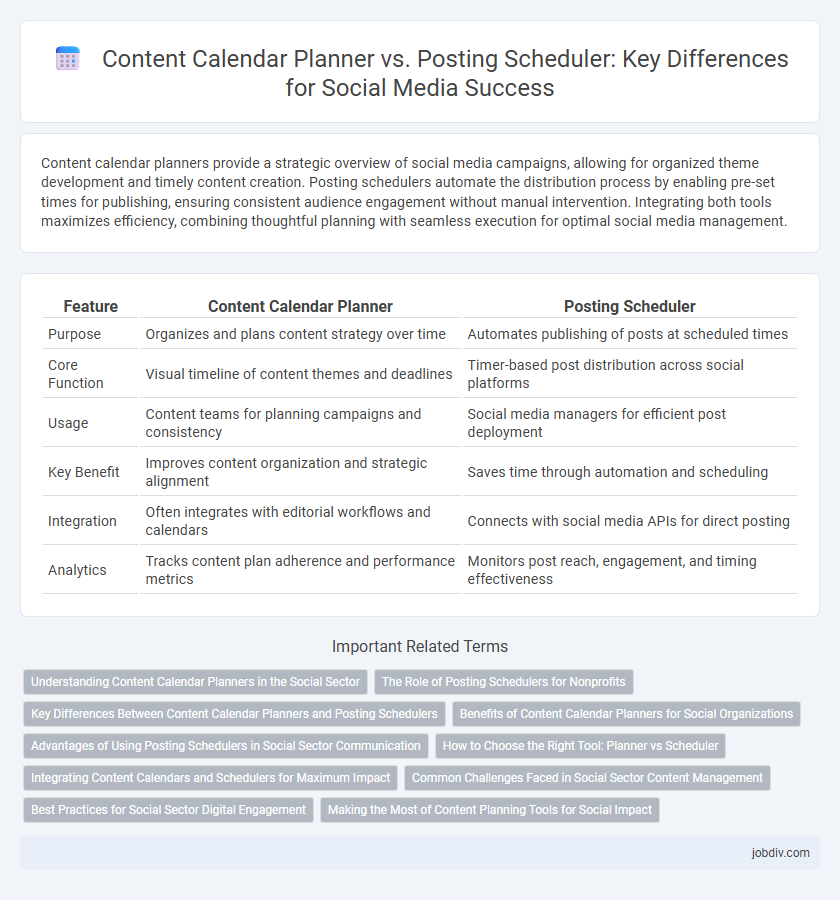Content calendar planners provide a strategic overview of social media campaigns, allowing for organized theme development and timely content creation. Posting schedulers automate the distribution process by enabling pre-set times for publishing, ensuring consistent audience engagement without manual intervention. Integrating both tools maximizes efficiency, combining thoughtful planning with seamless execution for optimal social media management.
Table of Comparison
| Feature | Content Calendar Planner | Posting Scheduler |
|---|---|---|
| Purpose | Organizes and plans content strategy over time | Automates publishing of posts at scheduled times |
| Core Function | Visual timeline of content themes and deadlines | Timer-based post distribution across social platforms |
| Usage | Content teams for planning campaigns and consistency | Social media managers for efficient post deployment |
| Key Benefit | Improves content organization and strategic alignment | Saves time through automation and scheduling |
| Integration | Often integrates with editorial workflows and calendars | Connects with social media APIs for direct posting |
| Analytics | Tracks content plan adherence and performance metrics | Monitors post reach, engagement, and timing effectiveness |
Understanding Content Calendar Planners in the Social Sector
Content calendar planners in the social sector streamline campaign management by organizing posts, events, and key dates into a cohesive timeline, enhancing consistency and audience engagement. These planners facilitate strategic content distribution tailored to social issues, awareness days, and community events, ensuring relevant messaging reaches target demographics effectively. Unlike posting schedulers, which automate publication timing, content calendar planners provide a comprehensive overview, enabling better coordination among teams and optimized resource allocation.
The Role of Posting Schedulers for Nonprofits
Posting schedulers streamline the social media management process for nonprofits by automating the timing and distribution of content, ensuring consistent engagement without manual intervention. These tools allow nonprofits to maintain a regular online presence, maximize reach during peak user activity periods, and free up staff to focus on mission-driven work. Integrating posting schedulers with content calendar planners enhances strategic planning while optimizing real-time execution across platforms such as Facebook, Twitter, and Instagram.
Key Differences Between Content Calendar Planners and Posting Schedulers
Content calendar planners focus on organizing and strategizing upcoming content by mapping out themes, deadlines, and publication dates, enhancing long-term campaign coordination. Posting schedulers automate the deployment of content to social media platforms at predetermined times, ensuring consistent audience engagement and reducing manual posting efforts. The key difference lies in content calendar planners serving as strategic blueprints, while posting schedulers handle execution and distribution efficiency.
Benefits of Content Calendar Planners for Social Organizations
Content calendar planners provide social organizations with a strategic overview, enabling efficient coordination of campaigns and timely content delivery aligned with key events and initiatives. These planners facilitate collaboration across teams, ensuring consistent messaging and saving time by organizing ideas, deadlines, and publishing schedules in one centralized platform. The ability to analyze content performance trends within the calendar helps optimize future social engagement and strengthens audience connections.
Advantages of Using Posting Schedulers in Social Sector Communication
Posting schedulers enhance social sector communication by ensuring timely and consistent delivery of messages, boosting audience engagement and trust. They facilitate automated publishing across multiple platforms, reducing manual effort and allowing staff to focus on strategic initiatives. Real-time analytics provided by posting schedulers enable data-driven adjustments that maximize outreach effectiveness and impact.
How to Choose the Right Tool: Planner vs Scheduler
Choosing the right tool between a content calendar planner and a posting scheduler depends on your workflow needs and team collaboration requirements. Content calendar planners excel in organizing ideas, mapping out campaigns, and coordinating posting timelines across channels, enhancing strategic planning and content consistency. Posting schedulers automate the publishing process by queuing posts at optimal times, ensuring regular audience engagement without manual intervention.
Integrating Content Calendars and Schedulers for Maximum Impact
Integrating content calendar planners with posting schedulers streamlines social media management by synchronizing content creation and automated publishing. This unified approach maximizes engagement by ensuring consistent posting aligned with strategic timelines and audience insights. Leveraging tools like Trello, Hootsuite, or CoSchedule enhances workflow efficiency and campaign effectiveness through real-time collaboration and data-driven scheduling.
Common Challenges Faced in Social Sector Content Management
Content Calendar Planners and Posting Schedulers both address the challenge of organizing and timing social sector content to maximize engagement and impact. Common issues include coordinating multiple campaigns, aligning with key events, and ensuring consistent messaging across diverse platforms. Inefficient integration between planning and automated posting can lead to missed deadlines and reduced audience reach.
Best Practices for Social Sector Digital Engagement
Content Calendar Planners enable social sector organizations to strategically organize and visualize campaigns, ensuring consistent messaging aligned with mission-driven goals. Posting Schedulers automate the distribution of content at optimal times to maximize audience engagement and reach across platforms. Combining these tools supports effective digital engagement by maintaining relevance, timing, and audience interaction in social sector communications.
Making the Most of Content Planning Tools for Social Impact
Content Calendar Planners provide a strategic overview of content themes and publishing timelines, ensuring consistent messaging aligned with social impact goals. Posting Schedulers automate content distribution by timing posts for maximum audience engagement across platforms, reducing manual effort and increasing reach. Integrating both tools enhances social campaigns by combining thoughtful content curation with precise execution, driving sustained awareness and community involvement.
Content Calendar Planner vs Posting Scheduler Infographic

 jobdiv.com
jobdiv.com